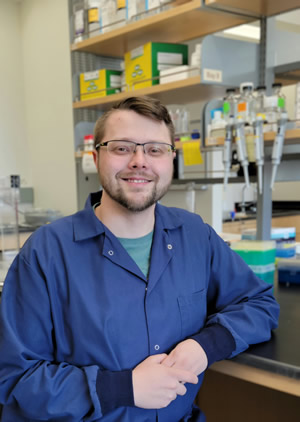Justin Mabinby Dr. Cornelia Kilchert  Justin Mabin is an NSF-GRFP fellow and PhD candidate in the Department of Biomolecular Chemistry at the University of Wisconsin (UW)-Madison, and is currently investigating variant small nuclear RNAs (snRNAs) and their impact on snRNP and spliceosome function. Justin obtained his Bachelor’s degree in Biochemistry and Molecular Biology from the University of Wisconsin-Eau Claire. He then joined the lab of Dr. Guramrit Singh at Ohio State University in Columbus, Ohio as a research assistant, where he studied the exon junction complex and got hooked on RNA biology. For Justin, these years as part of Ohio State’s Center for RNA Biology were formative. “I owe a lot of my success and early training to Dr. Singh.” It was the long history of RNA research and the presence of strong splicing groups that drew Justin to UW-Madison to pursue a PhD. He chose to work with Dr. Heidi Dvinge, who had only recently joined the department, to study variant snRNAs and their potential contribution to tissue- and cell type-dependent alternative splicing patterns. When Dr. Dvinge unexpectedly passed away in the second year of his PhD, Justin decided to continue his research on variant snRNAs, receiving immeasurable support from Dr. David Brow and Dr. Peter Lewis, who now co-mentor him. Nevertheless, the sad circumstances put him on a fast track to scientific independence. “I was really determined to continue working on my thesis project,” he said. “Dr. Dvinge had a unique skill set that was impossible to replace and challenging to supplement. To drive my project forward, I was forced to develop as an independent scientist.”
“Much of the research on the regulation of alternative splicing has focused on auxiliary splicing factors,” Justin points out. However, in many eukaryotes the major spliceosomal snRNAs are encoded by multigene families and evidence suggests that the levels of spliceosomal snRNAs and proteins contribute to regulating alternative splicing. “In this article,” Justin explained, “we identify and expand our understanding of variant snRNA-containing snRNPs and spliceosomes in humans. Like the canonical snRNAs, many snRNA variant genes display distinct expression patterns across cells and tissues, which suggests that variant spliceosomes containing noncanonical snRNAs may contribute to cell-type-specific alternative splicing patterns.” In particular, U5 snRNA variants were shown to be incorporated into spliceosomes at comparatively high levels. At present, Justin is excited to analyze the distinct alternative splicing changes that can be observed in a series of variant U5 snRNA knockout cell lines. However, working with snRNAs has not always been easy. “There are relatively few tools that exist to interrogate individual snRNAs. Therefore, I have had to spend a lot of time developing tools to directly study individual snRNA functions in splicing,” Justin said. He has some advice for budding RNA researchers, too: “Choose a mentor that you work well with and a research project that you are really passionate about. This combination will drive you through the difficulties of graduate school and scientific research, and together they will allow you to enjoy the successes even more.” Justin and his wife, who is also a scientist, had their first child just before he entered graduate school, and a second in the course of his PhD. “I have made it a priority to keep a good work-life balance while I have been in graduate school. I dedicate my evenings to my family, as well as most weekends. My other advice is to tell other students not to put your life on hold during graduate school. You can have a family and still be productive in the lab. Science is my passion, but so is my family.” Beyond his own research project, Justin seeks to inspire more students to pursue careers in the natural sciences, and RNA biology in particular. “Being a first-generation college student from a small town has driven me to focus on inspiring students from rural schools to consider futures in STEM,” Justin said. “I designed an outreach program at UW-Madison that integrates hands-on molecular biology experiments into the high school science curriculum.” During the COVID-19 pandemic, his outreach activities expanded. Among others, Justin sought “to address mRNA vaccine concerns, where I organized a panel of graduate student scientists to hold discussions with high school science classes/students.” After his PhD, Justin intends to stay part of the RNA research community. “I plan to stay in academia, and one day I hope to run my own lab and inspire other students the way many of my advisors have done for me”. Justin will be starting to look for post-doc opportunities soon. Unsurprisingly, his favourite RNA is the U5 snRNA, and his favourite RNA journal article is his recently published article from last year. You can find Justin on Twitter @mabin_justin. |
